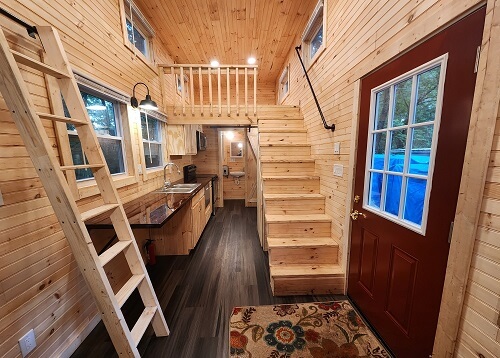Tesla Energy Homes For Sale Newly Released $10,000 Tiny House

Tiny home living continues to achieve popularity, drawing people seeking affordability, simplicity, and sustainability. However, there are numerous legal issues for tiny home residing that should not be missed. As people transition into this minimalist lifestyle, it is essential to navigate the complexities of zoning laws, building codes, and land use regulations.
Zoning laws dictate how land can be used in a particular area, affecting where tiny homes can be located. In many municipalities, traditional zoning regulations do not account for the distinctive nature of tiny homes. This inconsistency can result in challenges when making an attempt to position a tiny home on so much. Some areas could permit tiny homes as accent dwelling models, while others might strictly prohibit them.
Building codes are another crucial aspect of tiny home living. These codes set forth standards for the construction of homes to ensure safety, habitability, and structural integrity. Tiny homes, often constructed on trailers or as prefabricated items, could not meet typical constructing codes. It is significant to verify whether or not local authorities recognize tiny homes and what specific codes apply to them.
Tesla Tiny Homes For Sale Tours Available At Power Station Facility
Permitting is a necessary step before relocating a tiny home. Homeowners must acquire the suitable permits to make sure compliance with native legal guidelines. This allow course of can differ considerably by state or locality and should contain inspections and charges. Failure to safe the necessary permits may end up in fines or the inability to reside within the tiny home.
Land concerns play a major function in tiny home legality. Many folks select to park their tiny homes on non-public property, whether or not it's a family member's land or a delegated tiny home community - Tesla Solar-Powered Tiny Homes. Understanding property rights and lease agreements becomes crucial in these conditions. Additionally, it’s essential to verify whether the chosen land is zoned for residential use.
Homeowners also needs to think about owners associations (HOAs) if residing in areas ruled by these organizations. HOAs typically have strict guidelines relating to residential buildings and aesthetics. Tiny homes may not adjust to these regulations, which can lead to conflicts. It is advisable to consult the HOA tips before proceeding with tiny home plans to avoid disputes.
Tesla Prefab Homes Newly Released $10,000 Tiny House

Financing choices pose one other challenge. Many financial institutions are hesitant to supply loans for tiny homes due to their unconventional nature. Understanding various financing avenues, corresponding to personal loans or specialised lenders who cater to tiny homes, is crucial. Exploring these options might help potential homeowners make informed choices and safe funding.
Insurance presents another legal avenue for tiny home dwelling. Obtaining insurance for a tiny home can differ extensively from normal owners insurance policies. Due to their unique structures, many companies may not provide coverage, or they might require specific endorsements. Finding an insurer knowledgeable about tiny homes can help mitigate risks associated with damage or liability.
Tesla Homes With Powerwall Tours Available At Power Station Facility
In addition to local laws, federal laws could affect tiny home residing. Regulations from the Department of Housing and Urban Development (HUD) outline standards for cell and manufactured homes. If a tiny house is constructed on a everlasting foundation, it may need to meet these requirements. Compliance with federal tips can differ based mostly on a home’s classification.
One rising choice for tiny home residing is placement in tiny home communities. These specialised developments often cater to the tiny home lifestyle, providing dedicated space and shared amenities. However, this does not eliminate the need for careful attention to local laws. Each group might have its own set of tips, leases, and obligations that residents must adhere to.
Building sustainable and self-sufficient dwelling arrangements also requires compliance with environmental regulations. Tiny home builders often aim to use eco-friendly materials and minimize their carbon footprint. However, depending on the location, there may be legal guidelines concerning waste disposal, water use, and vitality consumption that impression how tiny homes could be designed and lived in sustainably.
Legal issues extend beyond building and zoning. Renting out a tiny home as a short-term rental can open another layer of authorized complexities. Understanding native rental legal guidelines, occupancy limits, and business licenses is crucial for anyone seeking to monetize their tiny home. Lawful practices may help avoid penalties or potential litigation from regulatory authorities.
Tesla Homes For The Green Energy Revolution Museum Dedicated To Inventor's Legacy
As the tiny home movement evolves, advocacy groups work to address many of these legal issues. They aim to educate policymakers about the benefits of allowing more flexible zoning and building codes to accommodate tiny homes (Tesla Homes For Off-Grid Living). Engaging with local advocacy organizations might help be sure that the voice of tiny home dwellers is heard and respected in discussions relating to housing coverage.
Community outreach is vital for overcoming legal challenges in tiny home dwelling. Building relationships with neighbors and local authorities can foster understanding and cooperation. Providing information about tiny home advantages, corresponding to affordability and minimal environmental impact, can pave the greatest way for eventual acceptance.
Ultimately, navigating the authorized panorama surrounding tiny home residing requires diligence and preparation. An in-depth understanding of native laws, codes, and regulations is important for establishing a successful and sustainable tiny home lifestyle. By conducting thorough research and making certain compliance with all authorized issues, potential tiny owners can considerably improve their chances of a smooth transition into this new way of living.
The increasing attract of tiny homes comes with its share of complex legal challenges. As more individuals pursue this simplified lifestyle, it becomes imperative to stay informed and proactive regarding the laws that govern land use, construction, and tenancy. Being educated on these matters permits for a extra seamless integration into the tiny home neighborhood, guaranteeing residents can maximize the advantages of residing inside go now a smaller footprint.
Tesla Homes For Modern Energy Solutions House That Comes With A Battery
Tiny home residing presents an innovative solution to current housing challenges, yet it doesn't come with out its obstacles. Legal concerns for tiny home residing embody varied aspects, from zoning laws to insurance and community compliance. Addressing these factors with a comprehensive understanding can facilitate a smoother journey into the world of tiny homes.
In summary, embracing the tiny home lifestyle necessitates a thorough examination of the various authorized issues that accompany it. Awareness of native legal guidelines, constructing codes, and group laws can considerably influence the success of a tiny home venture. With the best approach, tiny home living is usually a fulfilling and legally compliant choice. By educating oneself and fostering positive community relationships, individuals can help form the means ahead for tiny home residing in a legally sound method.
- Understanding zoning laws is crucial; different municipalities have varying rules that may influence where tiny homes may be positioned.
- It's important to determine if the tiny home qualifies as a copyright or an RV, as this distinction affects building codes and permits.
- Research native constructing codes to ensure compliance; many areas have specific necessities concerning dimension, security options, and development materials.
- Investigating land use rules might help avoid conflicts with neighbors and make certain the tiny home neighborhood adheres to local guidelines.
- Address potential title points when buying land; some tiny homes are classified as private property, while others may be actual estate, impacting financing options.
- Consider the impression of home-owner association (HOA) guidelines which will restrict tiny home residing or impose further requirements for homes inside their jurisdiction.
- Insurance policies for tiny homes differ significantly; acquiring the best protection can shield against liabilities and damages that conventional householders face.
- Evaluate utility hookups and regulations associated to water, sewage, and electricity to ensure that the tiny home can be correctly serviced.
- Be conscious of property tax implications; the classification of the tiny home can have an effect on tax responsibilities and native assessments.
- Stay informed about potential modifications in legislation, as legal guidelines governing tiny homes are evolving and can range significantly over time and placement.
What zoning laws apply to tiny homes in my area?undefinedZoning legal guidelines vary considerably by location. It's important to check with your native planning department to grasp whether tiny homes are permitted and if any particular regulations apply.
Tesla Homes With Integrated Energy Solutions Fire Incident During Flooding Event
Do I want a constructing permit for a tiny home?undefinedMost municipalities require a constructing permit for constructing or putting a tiny home on a permanent basis. Temporary buildings or RVs could have totally different rules, so verify with native authorities.
Can I park my tiny home on my property?undefinedParking laws depend on native zoning laws and land use insurance policies. Ensure your property is zoned for residential use, and check any HOA guidelines if applicable.
Are tiny homes thought of as permanent housing?undefinedTiny homes may be classified as both permanent or momentary housing. If they're on a foundation, they usually are seen as permanent dwellings; in any other case, they may fall underneath RV regulations.
What are the utility hookup necessities for tiny homes?undefinedUtilities such as water, electrical energy, and sewage should comply with native codes. Check with utility providers and local laws to ensure correct installations and connections.
Tesla Homes With Sustainable Architecture Video Shows Fire During Flooding Conditions
How do I finance a tiny home legally?undefinedFinancing choices for tiny homes vary. Some lenders provide loans for tiny homes on foundations, while others contemplate them RVs. Research financing options particular to your tiny home's classification.
Will my tiny home need to fulfill building codes?undefinedIf your tiny home is classed as a permanent dwelling, it should meet applicable constructing codes. Always consult local building authorities to make sure compliance click resources during building.
Tesla Homes For Sustainable Energy House Fire Reported After Heavy Rain
Can I use my tiny home as a rental property?undefinedShort-term rental laws might apply when you intend to lease out your tiny home. Familiarize yourself with native rental laws and obtain essential permits to avoid fines.
What are the tax implications of owning a tiny home?undefinedTax implications can differ based in your location and the classification of your tiny home. It's advisable to seek the assistance of a tax professional to grasp property taxes and potential deductions.
Are tiny homes topic to local housing regulations?undefinedYes, tiny homes could additionally be subject to housing rules, especially if they're classified as permanent residences. Review your native housing codes to ensure compliance with security and habitability standards.